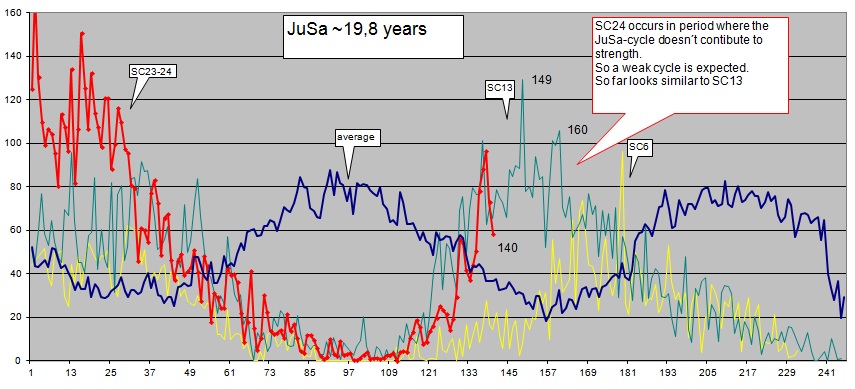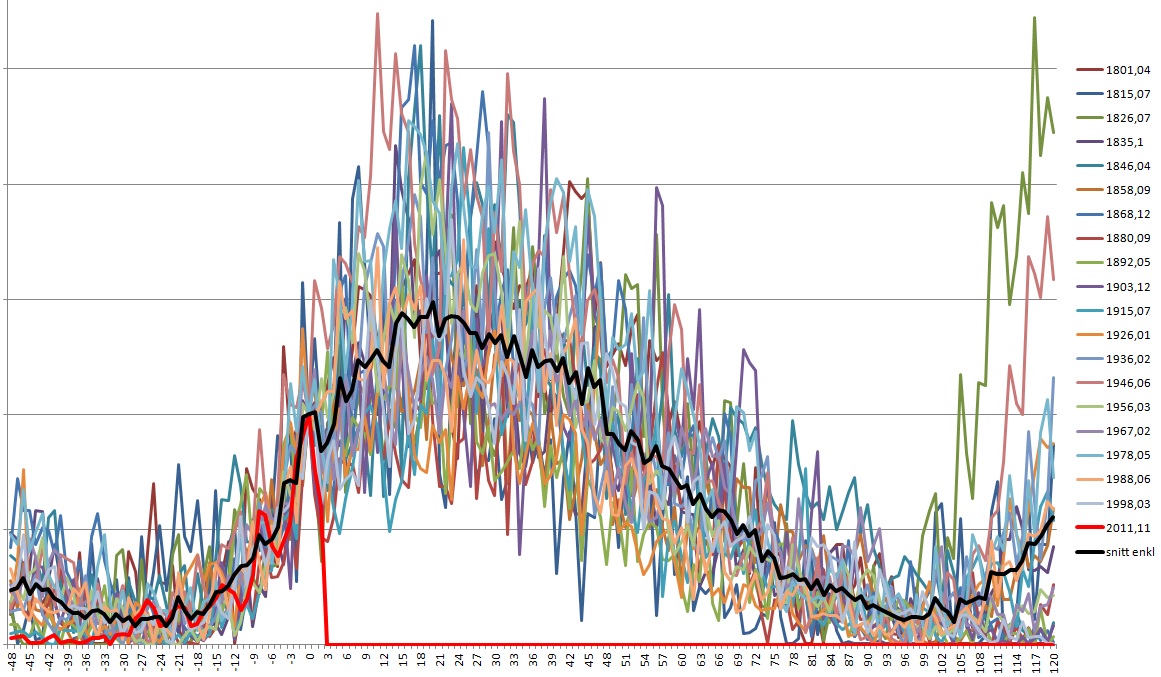|
|
Post by rangertab1 on Jan 14, 2011 14:59:27 GMT
As Jupiter approaches/reaches/passes perihelion (March 2011), should one expect a magnetic response between the two magneto giants?
Worded another way, as two magnetic fields draw nearer to one another, their is an increased magnetic relationship, no? If yes, what are some possible responses?
As we view the Sun from Earth, where is the shortest distance between the Sun and Jupiter? The eastern side?
Thanks for any insight.
|
|
bigbud
Level 3 Rank
  
Posts: 180
|
Post by bigbud on Dec 6, 2011 10:56:27 GMT
An update from the planetary cycles: SC24 is of the most normal kind of solar cycle relative to the Jupiter cycle (solar minimum relative to Jupiter perihelion) This projects a solar maximum around Oct 2012 to Nov 2013, and it may extend into 2014.  This is how the solar cycles classify to the Jupiter cycle, which mainly is a "timing cycle" that influences timing more than intensity.  The ~11yr VeEaJu-cycle is the most powerful timing-cycle, and can override the Jupiter-cycle. The VeEaJu-cycle also influences strength, and particulary the ability to kick-start cycles or extend them  The VeEaJu-cycle favors a rampup in intencity around Dec 2014 to March 2016. So this SC24 will not drop quicly, but extend its maximum, make a "hunchback" or long tail.  Tha last cycle is half the JuSa-cycle of ~19,8 years. This cycle has a big influence on intensity, and can have the ability to kickstart or extend cycles. In our SC24 we are out of phase with JuSa, so we should expect a weak intensity cycle. So far it may look similar to SC13.  |
|
|
|
|
|
Post by france on Jan 28, 2012 22:31:23 GMT
Bigbud, So If I understand, according to you maximum could occur between december 2014 and march 2016  |
|
bigbud
Level 3 Rank
  
Posts: 180
|
Post by bigbud on Jan 29, 2012 13:48:33 GMT
france This should be a "type-B" cycle, topping around 2013 But the VeEaJu-cycle says it wont dropp off quickly, but will be held up in 2015. So probable some kind of double/flat top, or a hump/shoulder, before dropping to minimum  |
|
|
|
Post by france on Jan 29, 2012 19:10:31 GMT
ok, so it could be between october 2012 and november 2013 ?
|
|
bigbud
Level 3 Rank
  
Posts: 180
|
Post by bigbud on Jan 29, 2012 23:23:53 GMT
france
I havent looked at it thoroughly... but somewhere at the top of the magenta curve above yes. It could even stretch into 2014.
These type-B cycles are the most commom ones, and represent the "equilibrium" state. The intensity is mostly dependant on whether the cycle is in phase with the Jupiter-Saturn cycle (which we are not now, so we should have a weak cycle).
We should stay in this state for several cycles, until the VeEaJu-cycle pushes the SC out of equilibrium and into the transitionary C-state
|
|
bigbud
Level 3 Rank
  
Posts: 180
|
Post by bigbud on Jan 29, 2012 23:36:55 GMT
hi again france  As you see here, the last ~100 years we have mostly had A- and C-type cycles. The green C-type is an unstable transitionary state, while the yellow A-type is a semi-stable state. In this phase with C- and A-type we typically have short cycles, that often locks (fall in phase) with the ~10 year Jupiter-Saturn cycle. This produces mostly strong cycles. Then we enter the stable magenta B-state, where we follow/lock into the Jovian cycle of ~12 years. In this state we can have strong or weak cycles, depending on whether the JuSa-cycle is in phase or not. We stay in this B-state until the ~11 year VeEaJu-cycle forces early start of solar cycle, and shortening of the preferred/stable ~12 year cycle. We then move into the C-state, and have completed a "supercycle"  |
|
|
|
Post by france on Jan 31, 2012 22:35:41 GMT
I didn't understand very well what you mean bigbud but it looks like "super"
dr Svalgaard already said it's no sense egbr (he deleted his post)
we'll see if maximum occurs in 2014 as bigbud calculated.
Nobody knows really if JVEa have yes or not any influence.
|
|
bigbud
Level 3 Rank
  
Posts: 180
|
Post by bigbud on Feb 1, 2012 11:32:17 GMT
Hi I havent really given any prediction for the date of maximum... I would then have to do more work on short-time cycles  But the overall picture is that we will have several solar cycles (most of this century) that are B-cycles. These are long cycles (average ~12 years) and with a bias for weaker cycles. Of course this is all just speculation for fun  If I live another 50 years, it will be fun to see if I found the right interpretation. When using this method/cycles in the past, I see that there are some unpredictable outcomes (cycles that didnt become excactly what the cycles predicted). The critical point is at what time a solar cycle begins. One can make a prediction on when it is likely to begin, but first when one has the date for solar minimu, one can make a real prediction for the current solar cycle. |
|
|
|
Post by france on Feb 5, 2012 20:21:43 GMT
Bigbud, as you say Ju-Sa cycle follows solar cyle 24 et 13, why don't you show the prospective curve with Ju-Sa cycle to see where the max could be and the weaker period of course ! just for fun  |
|
bigbud
Level 3 Rank
  
Posts: 180
|
Post by bigbud on Feb 6, 2012 8:38:34 GMT
Hi france  When comparing with JuSa and SC13, we could have maximum in approx 9-20 months from now (the average topping probably somewhere in the middle)  And when looking at the average cycle, we could top in about 18 months  So I guess around summer 2013 is so far my best guess for maximum  BB ---------------- about the next minimum: we are in a B-cycle, and the next one should be a B-cycle. So the minimum is expected in a certain interval beofre the Jupiter perihelion. A very quick approximation says minimum around summer 2020. ------------ I found this old page I made. I guess those estimates are still valid home.broadpark.no/~elic/solarcycle3.html |
|
|
|
Post by france on Feb 6, 2012 15:27:18 GMT
ok bigbud, we are all agree with you
|
|
|
|
Post by france on Feb 19, 2012 2:18:22 GMT
|
|
andor
Level 2 Rank
 
Posts: 60
|
Post by andor on Mar 24, 2012 13:27:14 GMT
As human beings it is natural that we all want to see beginning and end, a cycle etc.
Nice to have all the graphs and trends of cycles so we can then foretell what's coming?
Sorry guys but the truth of the matter is there are no cycles. Why? Because of time and time = change and movement.
|
|